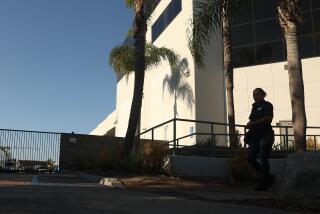Op-Ed: A high school soccer player’s death is linked to extreme heat. Why it was 100% preventable

- Share via
After participating in a club soccer practice last August in Chino on one of the hottest days of the year, 17-year-old Shane Thomas collapsed and died. This month, the San Bernardino County Coroner’s Division ruled that extreme heat played a role in his death.
He died from “hyperthermia due to elevated environmental temperature,” the autopsy report said. The temperature had reached 111 degrees around the time of practice.
Shane didn’t have to die. Athlete deaths related to heat exertion are 100% preventable. Unfortunately, California has a severe shortage of policies that could prevent such deaths.
Last August, the University of Connecticut’s Korey Stringer Institute updated its rankings that judge how well each of the 50 states and Washington, D.C., have done implementing health and safety polices aimed at preventing the leading causes of sudden death in middle and high school athletics. California dropped a rung, from 50th to last place.
This ranking is unacceptable and must change.
California lacks enforceable policies because its guidelines — as outlined by the California Interscholastic Federation and the National Federation of State High School Assns. — are only recommended. Even if policies were mandated by these organizations, they would not apply to club or travel sports teams.
We need statewide requirements for youth athletics that include prevention and emergency-care policies related to exertional heatstroke, traumatic head injuries, sudden cardiac arrest, emergency preparedness and appropriate healthcare coverage. Without them, we put our student-athletes in unnecessary danger every day they practice and compete.
Participation in athletics is never 100% safe, but the absence of appropriate healthcare personnel and well-developed emergency preparedness policies greatly and unnecessarily increases the risk.
According to a June 2020 report by the National Center for Catastrophic Sport Injury Research, 48 athletes had died and 131 had endured catastrophic injuries participating in California sports since 2005. At the high school level, 34 student-athletes had died and 92 had endured catastrophic injuries, according to the report. That equates to about 2.3 deaths and 6.1 catastrophic injuries per year at the high school level. Nearly 80% of these deaths occurred during official school or team-related practice, training or competition.
Absent statewide regulation in California, it is up to individual schools and club teams to implement appropriate safety policies. In extreme heat, practices should either be canceled or last at most an hour, which should include a minimum of 20 minutes of rest in a shaded area and unlimited access to water or electrolyte drinks.
This lack of compliance with nationwide best practices has led to tragedy, repeatedly costing young athletes their lives. Shane was an All-City soccer player who was going to be the team captain at Palisades High.
Shane Thomas, a Palisades High soccer player, died last year while practicing in extreme heat.
Implementing widely accepted and evidenced-based strategies could eliminate the deaths of young athletes due to exertional heatstroke. California should embrace key best-practice recommendations — developed by a coalition of 14 sports medicine-related groups — aimed at preventing sudden death in high school athletics.
Recommendations specific to exertional heatstroke include:
Start slowly: Develop a 7- to 14-day acclimatization period for athletes in the heat, with specific criteria for progressively increasing the intensity and duration of physical activity.
Gauge heat: Assess heat and humidity conditions at the site of the physical activity using a wet-bulb globe temperature device or by viewing the heat index online.
Modify practice: Require an evidenced-based heat-modification policy based on the temperature or the heat-stress reading, such as shortening or rescheduling the activity and increasing access to hydration.
Emergency cooling: Make cold-water immersion tubs available on-site for emergency cooling for any athlete suspected of exertional heatstroke — a critical step in saving lives.
Proper personnel: Have certified athletic trainers at all practices and competitions involving physical collision and contact so that immediate emergency care can be provided.
In recent years, California has made some progress in improving athlete safety, including passing legislation concerning return-to-play criteria after concussion, requiring emergency action plans, improving access to automated external defibrillators and requiring training so that coaches can recognize dangerous signs and symptoms. Even with these steps forward, California still placed last in the Korey Stringer Institute’s health and safety policy rankings for preventing sudden athlete death in middle and high school athletics.
More steps are needed. Requirements for implementing best-practice policies for preventing sudden athlete death must be established, appropriate healthcare professionals must be on site and athletic trainers must be licensed. California is the only state in the country that does not require regulation of athletic trainers.
Nearly 200,000 high school athletes in California do not have access to a certified athletic trainer, according to a 2019 study I was co-author of. Many of the schools without a certified athletic trainer were in lower socioeconomic areas. In addition, 7% of high schools reported having an athletic trainer who did not meet national education or certification requirements for providing healthcare for athletes.
To keep student-athletes safer and prevent the spread of COVID-19, certified athletic trainers were essential to the creation of comprehensive plans for developing and implementing critical infection control measures (including coronavirus testing) and return-to-play criteria for professional, intercollegiate and secondary-school athletes.
A coalition of groups that includes the National Football League, the National Athletic Trainers’ Assn. and the California Athletic Trainers’ Assn. is working together to come up with best practice recommendations that could reduce catastrophic and sudden-death injuries in athletics at our state’s high schools.
California can and must do better to protect the health and lives of its student-athletes — and provide greater access to qualified athletic healthcare, especially in lower socioeconomic areas. The state must make it a priority to put in place best practice policies that focus on athlete healthcare and minimize the chances of sudden death from playing sports.
Jason Bennett is an associate professor of kinesiology at Cal State Fullerton and past president of the California Athletic Trainers’ Assn.
More to Read
A cure for the common opinion
Get thought-provoking perspectives with our weekly newsletter.
You may occasionally receive promotional content from the Los Angeles Times.











